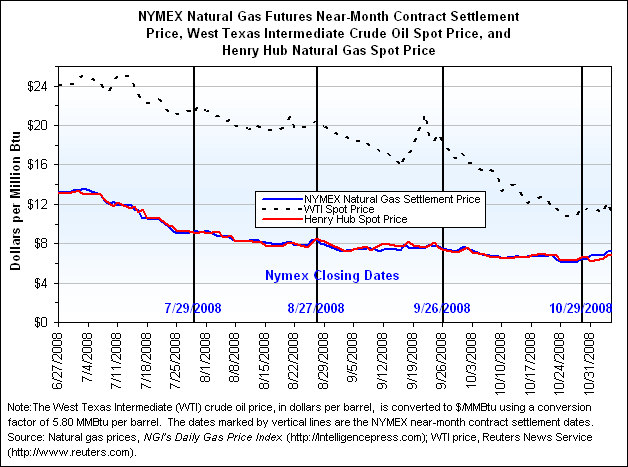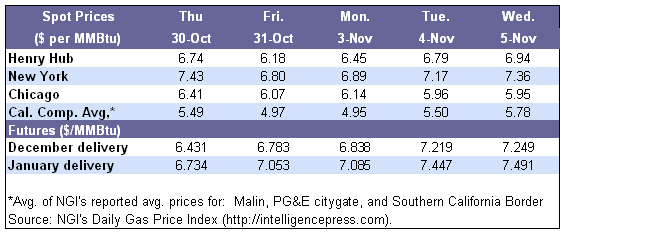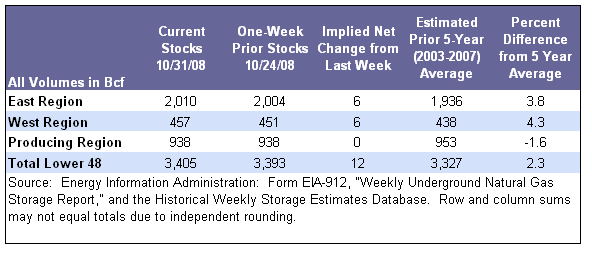
Natural Gas
Natural Gas Weekly Update Archive
for week ending November 5, 2008 | Release date: November 6, 2008 | Previous weeks
Next Release: November 14, 2008
| Overview | Prices | Storage | Other Market Trends | Natural Gas Transportation Update |
- Since Wednesday, October 29, natural gas spot prices increased at most markets in the Lower 48 States outside the Midwest, Northeast, and Alabama/Mississippi regions, with gains of up to $1.26 per million Btu (MMBtu) in a week of highly variable prices. Prices at the Henry Hub rose 36 cents per MMBtu or about 5 percent, to $6.94 per MMBtu.
- At the New York Mercantile Exchange (NYMEX), the futures contract for December delivery at the Henry Hub settled yesterday (November 5) at $7.249 per MMBtu, climbing 47 cents per MMBtu or about 7 percent since last Wednesday, October 29.
- Natural gas in storage was 3,405 billion cubic feet (Bcf) as of October 31, which is about 2 percent above the 5-year average (2003-2007), following an implied net injection of 12 Bcf during the report week.
- The spot price for West Texas Intermediate (WTI) crude oil decreased $2.04 per barrel on the week to $65.41 per barrel or $11.28 per MMBtu. At $65.41 per barrel, the crude oil price is 55 percent below the record-high price of $145.31 posted on July 3, 2008, and 30 percent below the $94.06 level recorded last year at this time.

Natural gas spot prices increased on the week at most market locations, with increases of up to $1.26 cents per MMBtu. Factors contributing to the rising natural gas prices likely included cooling temperatures in most parts of the Lower 48 States and continuing production shut-ins of 2.1 Bcf per day in the Gulf of Mexico.
The largest average regional price increases occurred in the West Texas, Midcontinent, Rocky Mountains, and Arizona/Nevada regions, with prices at most markets in the regions climbing between 60 and 80 cents per MMBtu, or 13 to 21 percent, since last Wednesday, October 29. West Texas recorded the largest regional average price increase climbing 80 cents per MMBtu, or about 21 percent. The Midcontinent posted the next largest increase since last Wednesday, rising 75 cents per MMBtu. Prices in the Rocky Mountains and Arizona/Nevada regions rose 67 and 60 cents per MMBtu, respectively. Elsewhere, regional average price increases ranged between 24 and 44 cents per MMBtu.
In contrast to the pattern of rising prices elsewhere in the Lower 48 States, prices in the Midwest, Northeast, and Alabama/Mississippi regions posted declines since last Wednesday. Relatively mild temperatures in the Midwest and Northeast regions likely contributed to the declines in these regions, as prices fell 5 and 25 cents per MMBtu on average, respectively. Prices at the Chicago citygate in the Midwest and the Algonquin citygate in the Northeast posted the largest week-on-week declines in their regions, falling 59 cents per MMBtu and 51 cents per MMBtu, respectively. Prices in the Alabama/Mississippi region fell 5 cents per MMBtu on average.
Natural gas prices exhibited considerable variability during the report week, particularly in the Midcontinent region. Prices fell between $0.32 and $2.37 per MMBtu at all market locations on Friday, October 31, amid moderating temperatures, high linepack conditions on several pipelines with few storage injection alternatives, and light weekend industrial demand, as the market appeared generally oversupplied. This pattern of volatile prices was especially pronounced in the Midcontinent region, where the average spot price fell to 85 cents per MMBtu at the Centerpoint East market location in Oklahoma on Friday, October 31. In trading on Monday, November 3, prices recovered with the returning industrial demand, and with expectations of colder temperatures moving into the Lower 48 States. However, at one point in trading Monday, November 3, prices on the Centerpoint East fell to 2 cents per MMBtu before rallying. On Wednesday, November 5, prices at the Centerpoint East market location averaged $4.54 per MMBtu.

At the NYMEX, the prices for natural gas delivery contracts through November 2009 rose between 38 and 47 cents per MMBtu, or 5 to 7 percent, since Wednesday, October 29. Prices for the 12-month futures strip (December 2008 through November 2009) averaged $7.61per MMBtu as of Wednesday, November 5, rising by roughly 41 cents per MMBtu, or about 6 percent on the week. Contracts for delivery during the heating season (December 2008 through March 2009) averaged $7.44 per MMBtu, and traded at an average premium of 50 cents per MMBtu relative to the spot price.

Working gas in storage increased to 3,405 Bcf as of Friday, October 31, according to EIA’s Weekly Natural Gas Storage Report (see Storage Figure). The implied net injection of 12 Bcf into working gas was 19 Bcf less than the 5-year average net injection of 31 Bcf, and was 32 Bcf below last year’s net injection of 45 Bcf for the same report week. Working gas stocks are now 130 Bcf below last year#8217;s level at this time compared with the peak difference of 389 Bcf as of July 4, 2008. Working gas is 78 Bcf above the 5-year average.
Colder-than-normal temperatures in the Lower 48 States likely contributed to the below-average level of net injections into working gas storage. The National Weather Service’s degree-day data (see Temperature Maps and Data) indicate that temperatures in the Lower 48 States were below normal levels during the week. On average, temperatures were 3 percent below normal in the Lower 48 States. The pattern of colder-than-normal temperatures prevailed throughout most of the Lower 48 States, as each Census Division, excluding the Pacific and Mountain Census Divisions, reported temperatures that were between 2 and 12 percent below normal.

Recap of the 2008 Natural Gas Injection Season. The 2008 refill season (April 1-October 31) ended with an estimated 3,405 Bcf of working gas in storage. Natural gas inventories ended the 2007-2008 heating season with 1,247 Bcf in storage, which was about 2 percent lower than the 5-year average for that time of year and remained below the historical averages through the second week of August. In all, 2,158 Bcf was injected into storage during the refill season, based on EIA’s weekly storage data, which is about 5 percent higher than the 5-year average net refill of 2,056 Bcf. The difference between actual injections and the 5-year average is the equivalent of 0.5 Bcf per day for the season.
The high injections into underground storage this past refill season are attributable to a number of factors. First, natural gas domestic production grew compared with last year, even with the hurricane activity that occurred in August and September. While a total of 195 Bcf of natural gas Federal offshore production in the Gulf of Mexico was shut in as of October 30, according to the Minerals Management Service, and liquefied natural gas (LNG) imports were significantly lower than in 2007, onshore production, particularly gas shale production, was high enough to offset the production losses in the offshore and the downturn in LNG imports.
Another factor contributing to the high storage level was the economic incentive to inject gas that prevailed throughout the refill season. Average NYMEX contracts priced for delivery during peak winter months (December 2008 through February 2009) exceeded Henry Hub spot prices. The average differential for the season was $0.98 per MMBtu, which was significantly smaller than last year’s differential of more than $2 per MMBtu, but still enough to serve as an economic incentive to inject natural gas into storage.
GAO Releases Report on Oil and Gas Drilling. The Government Accountability Office (GAO) in its November 4, 2008, report found that the Department of Interior makes less effort to encourage development of Federal oil and gas leases than some State and private landowners. Eight States reviewed by the GAO were found to have undertaken more efforts to encourage oil and gas leases, using increasing rental rates, shorter lease terms, and escalating royalty rates. Although the Department of Interior used varying lengths of leases for offshore areas, with deeper waters receiving longer lease terms, this provision is not explicitly related to the expected productivity of the lease. On the other hand, five of the States that GAO reviewed--Alaska, Louisiana, Montana, New Mexico, and Texas--vary lease lengths or royalty rates to reflect the likelihood that the lease will produce. GAO reviewed data on about 55,000 offshore and onshore Federal leases issued from 1987 through 1996. Development occurred on about 26 percent of offshore and 6 percent of onshore leases issued during that period, while production occurred on about 12 percent of offshore leases and 5 percent of onshore leases. The number of offshore leases issued annually from 1987 through 2006 had two large peaks—in 1988 and 1997—and has generally been increasing since 1999. Onshore leases peaked in 1988 and then declined until about 1992, remaining at these lower levels until about 2003 when they increased, coinciding with rising oil and natural gas prices. The GAO also found that leases with shorter primary lease terms of 5 years were developed more quickly than leases with 10-year terms.
- Southern California Gas Company on Wednesday, November 5, said it had restored injection capacity of 410 million cubic feet (MMcf) per day at its Aliso Canyon storage facility in Los Angeles County, California. Injection capacity at the facility had been limited following a lightning strike at the facility over the weekend.
- Transcontinental Gas Pipe Line Corporation (Transco) on November 5 said it will begin receiving flows from six meters on a portion of its Southeastern Louisiana Lateral offshore Gulf of Mexico. Transco was able to return service to these meters following completion of repairs resulting from damage from Hurricane Ike.
- Colorado Interstate Gas Company (CIG) on November 5 said it must extend restrictions on balancing gas flows because storage levels have reached their maximum limit and linepack on its system is high. An operational warning about pipeline load factors and imbalance conditions, first issued in early October, will continue through at least November 11. The pipeline system remains “highly sensitive to transportation and operational imbalances with little or no ability to accommodate imbalance makeup activity,” according to the company.
- CIG also reported that throughput capacity at its Laramie Compressor Station in Wyoming has increased to 680 MMcf per day, following the early completion of maintenance on one of the units there. CIG on Wednesday (November 5) said that a second compressor unit at the station was still unavailable. The Laramie Station normally has throughput capacity of 770 MMcf per day.
- Northwest Pipeline Corporation said Sunday it had experienced excessive linepack south of its Kemmerer Compressor Station in Lincoln County, Wyoming. Because of relative high levels of storage at its Clay Basin storage facility in the region, all nominations and receipts from the pipeline should be balanced until further notice, according to the pipeline company.
See Weekly Natural Gas Storage Report for additional Natural Gas Storage Data.
See Natural Gas Analysis for additional Natural Gas Reports and Articles.
See Short-Term Energy Outlook for additional Natural Gas Prices, Supply, and Demand.